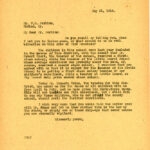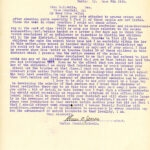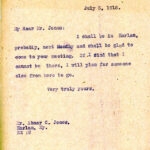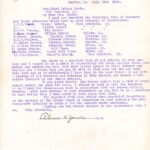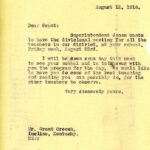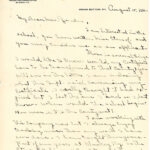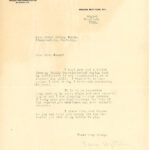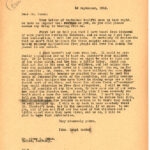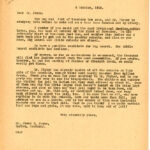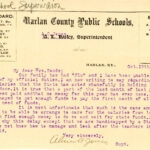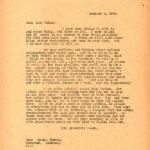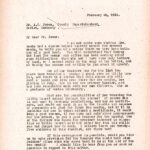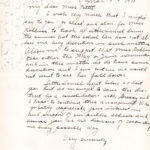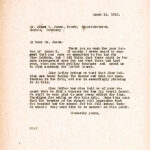Pine Mountain Settlement School
Series 13: EDUCATION
County School Supervisor Correspondence 1918-1919
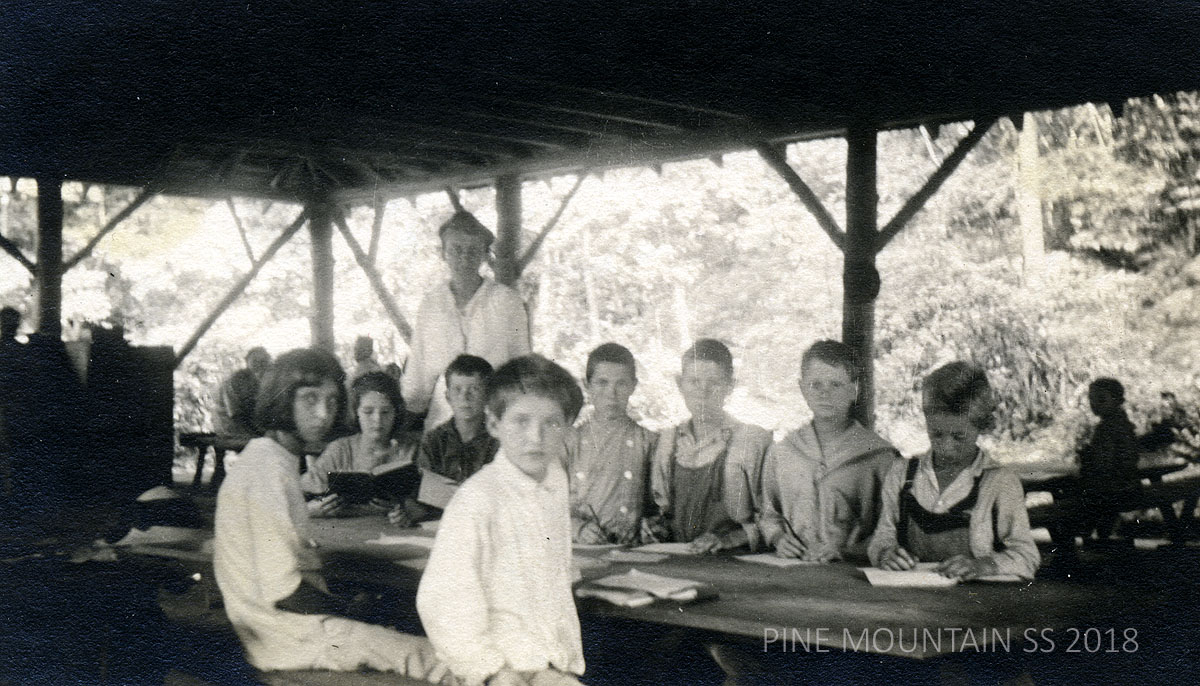
Students in the House in the Woods, early 1900s, open classroom at PMSS. [II_2_early_days_124]
TAGS: Harlan County Schools, Superintendents, Harlan County Public Schools, education, 1918-1919, Abner C. Jones, Superintendent of Schools, Board of Education, Pine Mountain Settlement School, Ethel de Long Zande, Miriam Noland, F.D. Perkins, Divide School, Kenneth Nolan, Jim McKnight,Grant Creech
EDUCATION County School Supervisor Correspondence 1918-1919
This collection of correspondence and documents between Pine Mountain Settlement School and the Superintendent of Harlan County Schools, Abner C. Jones in 1918 reveals the difficulty of reliably serving the needs of remote schools. The topics of discussion center on the availability of staffing, funding, and quality of schools on the north side of Pine Mountain and the transfer of that supervisorial responsibility to Pine Mountain Settlement School.
The dogged determination of Ethel de Long Zande and her co-founder, Katherine Pettit, to engage public funding and consistent staffing for the surrounding schools from the Superintendent of Harlan County Schools was revealed in the correspondence to be unwavering. The correspondence also reveals an apparent insensitivity, or, at the least, the inability of the county school system to grasp the severity of the problems or commit to funding the most rural schools in the county. The failure to equitably serve the county is clearly revealed in the correspondence. The Superintendent’s response was all too common in counties with large numbers of rural schools that lacked adequately trained teachers and consistent funding, as it was only marginally better at the State level during the early years of the twentieth century.
RURAL SCHOOLS
Education in the more remote areas of the mountain counties was often the most overlooked service and this fact was one that the relatively new settlement school at Pine Mountain planned to overcome by working with the state school system and the other settlement institutions in the mountains. The response of Superintendent, Abner C. Jones of the Harlan County Public Schools system was clearly at first restrained in the effort, but when called to accountability by Ethel de Long Zande and Katherine Pettit, the problems began to be acknowledged by Superintendent Jones and remediation could be joined — sort of.
It took some time for the actions of Ethel de Long Zande and Katherine Pettit to eventually bring some accountability and better rural schools to the Northside of Pine Mountain and to call attention to the other remote schools within Harlan County. A review of the work of Zande and Pettit with schools across the mountain area of the state shows that schools and education within the schools benefited from the aggressive work of the settlement schools and their workers during these early years. And, the work was aggressive.
NORTHSIDE OF PINE MOUNTAIN SCHOOLS
In 1918 de Long Zande asked Supervisor Abner C. Jones for a list of the teachers within the northside of Pine Mountain section of supervision. He supplied the following
| NAME | SCHOOL | LOCATION | |
| 1. | R.B. Short | Greasy School | Pine Mountain, Ky |
| 2. | [indecipherable] | Little Laurel | Pine Mountain, Ky |
| 3. | Bird Turner | Big Laurel | Pine Mountain, Ky |
| 4. | Dora Creech | Dillon School | Dillon Ky |
| 5. | Grant Creech | Incline School | Incline, Ky |
| 6. | W.H. Tolliver | Bledsoe School | Bledsoe, Ky |
| 7. | Thelma Howard | Ruben’s Branch | Baxter, Ky |
| 8. | Mellie Howard | Straight Creek | Gross, Ky |
| 9. | Marda Taylor | Salt Trace | Layman, Ky |
| 10. | Viola Howard | Upper Salt Trace | Gross, Ky |
| 11, | W.H. Turner | Abner’s Branch | Pine Mountain, Ky |
ABNER C. JONES AND ETHEL DE LONG ZANDE
Responding to the request of Pine Mountain Settlement School, the School Board at the direction of the Superintendent, Abner C. Jones, appointed Marguerite Butler and Ethel de Long Zande as Supervisors of the Pine Mountain section which included all the schools listed above. The original list included Baxter, Kentucky, a small community near the town of Harlan, to which Zande immediately replied that Baxter needed to be removed from the list as it was on the opposite side of the Pine Mountain and closer to Harlan town. Jones removed the location.
When Superintendent Jones suggested that Zande use Greasy [Creek] School as a model site, she advised the Superintendent that the Greasy School was inappropriate for a model school as there was no teacher there. She then suggested that Incline School and its teacher, Grant Creech would be better for a model school program.
When Jones first responded to both suggestions he used the opportunity to suggest that the error of the Baxter suggestion was possibly due to Mrs. Zande’s confusion and he then made his own recommendations regarding the staffing of vacant schools, particularly Reuben’s Branch, but placed the responsibility on the shoulders of Zande and the Pine Mountain to locate teachers for the vacated positions. He wrote that regarding the staff at the schools, he was “having considerable difficulty in securing teachers who are at all worthwhile.”
Following these early exchanges, the relationship of Superintendent Jones and Ethel de Long Zande appeared to improve. The challenges were, however, daunting. No doubt, the county was not making efforts to resolve the long-standing problems of the remote schools. Further, the dire instructional situation was exacerbated by WWI and the large number of qualified men and women who had left the county to join the war effort. A third impediment would appear late in 1918 in the form of the 1918-19 Pandemic.
INTERVENTION PLAN
The request of Ethel de Long Zande to become a county school supervisor was part of the early plan of Pine Mountain’s outreach and was generated by the two directors, Ethel de Long Zande and Katherine Pettit. Their plan included an expansion of their outreach with satellite schools and medical facilities, directed by the main settlement school at Pine Mountain. But, it is likely that neither of the co-directors anticipated the obstacles to their plan for satellite sites under the supervision of Pine Mountain to be so very difficult within the patriarchy of the Harlan County School system.
In a letter to Hindman director, May Stone, Zande and Pettit returned to their previous experiences and plans that worked while staff at Hindman Settlement. They wrote to Stone seeking advice and guidelines regarding recruitment for the 11 schools now under their supervision. Ethel de Long Zande specifically requested assistance in locating possible recruits who had Miss Stone’s confidence and who may have worked in Knott County, near Hindman. May Stone immediately took on the challenge and put out feelers for certified teachers she knew and who might be interested in filling the vacancies in the Pine Mountain supervisory section.
Sarah Hylton became the focus of recruitment at the urging of Stone, but her expired certification created problems, leaving Zande and Pettit still at a loss in filling the teacher positions in a timely manner. With no teacher prospects in sight for most of September and into October, Mrs. Zande, obviously perturbed, wrote to Superintendent Jones on another troublesome matter. She asked why county paychecks were not going out to teachers as many teachers related that they had not been paid for the school year (a six-month contract). Zande wrote to Jones
My dear Mr. Jones:
I hope you won’t consider this a prying letter, but I am asking so many times why the teachers are not receiving any pay, and haven’t been paid in full for last year’s work, that I would love to know from headquarters, what the situation is.
It seems to me, that if there is a good explanation, it would be a help to people to know what it is. I hear constantly that certain teachers “aiming to quit”, because they haven’t been paid for last year’s work yet.
Sincerely yours,
Letter of October 11, 1918 Ethel de Long Zande to Mr. A.C. Jones, County Superintendent of Schools.
In October Mrs. Zande received her answer. Both of the Superintendent’s justifications were ominous. Mr. Jones writes
My dear Mrs. Zande: October 19th, 1918
Our family has had “Flu” and I have been unable to attend to any of my official duties. I am now writing to say regarding the teacher’s salaries that the State has acted shamefully in holding them up as it has done. It is true that a part of the last month of last year has never been paid and the no money for this year has ever come. I have however managed to get enough funds to pay the first month of all who are in real need of funds.
It is most unfortunate that such is the case and I am expecting to be able to arrange to care for the salaries from local funds if I can find enough money to do so and wait for state funds. I can not explain why this delay except that we are handicapped by a State Supt. who does not know how to manage and look after the teachers interest as he should.
Very sincerely,
Abner C. Jones, Supt.
SCHOOLS AND THE 1918 PANDEMIC
The “Flu”, the infamous 1918 Pandemic, was just beginning in Harlan County and would take an enormous toll on the populations of the coal camps where sanitation and close quarters guaranteed a large outbreak. [See: Dancing in the Cabbage Patch – Dis-ease] The reportedly inept State Superintendent, V.O.Gilbert, was just beginning to deal with school closures throughout the state due to the disease. Further, the lack of an “annual” pay check was not as ominous as it sounds in the letters from Zande, as teachers were only hired for six months, the duration of the school year in 1918. However, to be without a paycheck for 6 months is no incentive to take on any of the rural teaching positions, though they generally paid $45 for the six months and a $15 supplement for dwellings. It was quite simply a subsistence wage and one largely earned by women teachers throughout the State.
Letter from A.C. Jones to Ethel de Long Zande, October 19th, 1918
THE NEW “NORMAL”
On October 25, 1918, Ethel de Long responded to Jones and she empathizes with him to a degree, but takes aim at his local educational priorities by cynically noting that she is “… so glad to know what to say to people when they ask if it was the fault of the last County School Board.” She expresses regret for the family illness and notes that Pine Mountain has been successful in keeping the pandemic at bay …“so far.” Softening her criticism, she says of the year
I wonder if we wouldn’t all describe the year so far as ‘doing our darndest’ rather than our best?
Ethel was an expert at doing her “darndest”. She again began a barrage of letters in which she returned to the recruitment dilemma. The back-and-forth letters worked. By January she offered Jones a plan to create a Normal Course (a teacher preparation program) in the Pine Mountain curriculum that will hopefully provide trained teachers to the community schools from an educational preparation program directed by Pine Mountain teaching staff. Quickly, by mid-January of 1919, she wrote to the State Superintendent of Schools to initiate a Normal Course (teacher education curriculum) of study at the Settlement School. It was a program she described as a long-range plan with the expectation that it would take two years to raise the program to a level to produce first-class certification but that second-class certification would be approved and would serve to fill the gap in recruitment.
Marguerite Butler, one of the Pine Mountain Staff wrote to her in 1918 and mentioned that there was an attempt t fill vacant school positions
This is teacher’s institute week and a special meeting we had to come to. They have divided the county into six districts. In our district, there are ten rural schools, some nearly 20 miles away. We are to have supervision over those schools. It’s just what Miss Pettit and E. de L[ong] have wanted and to think this should have been suggested by the county superintendent. I guess I’ll have the job.
Marguerite Butler was one of the most skilled workers at the School but even she could not turn the situation around even with the full backing of both Pettit and Zande.
Ethel de Long pursued the idea only for a brief time, even pleading with friends of staff members who might like to come to the mountains and try their hand at teaching. When those ideas were relayed to the Superintendent, he quickly blunted her initiative with his response. He suggested that though the candidates may be talented, even Zande’s recommendation of hiring a highly skilled staff member would be quickly defeated at the State level. He replied to her suggestions with his deflating response that “...school law does not allow me any discretion in such matters…” and further, that the necessity to take a State exam could not be circumvented. In the State all prospective teachers were required by law to take the Kentucky teacher’s exam, regardless of educational degree. As the ideas on both sides floated in the ether, weeks went by.
By March of 1919, Ethel de Long Zande, as a county school supervisor, had dug in and Katherine Pettit had re-joined her persistent pursuit for resolution of prolonged instructional vacancies in the small rural schools. Katherine Pettit wrote in support of her colleague, Ethel Zande to Superintendent Jones, that it was the settlement schools’ intention to continue to pursue a solution to the empty schoolhouses on the north side of Pine Mountain. She, like Zande, in essence, tells Jones that
” Doing their darndest” was, after all, what Pine Mountain knew “… how to do well.”
This “darndest” persistence was eventually fruitful.
[To see an excellent article on the educational state of Kentucky in late Fall of 1918, refer to “Traces of Laurel: 1918 Pandemic Part 9”, by the Laurel County Public Library and posted in the Laurel County Sentinel Echo on June 11, 2020.]
GALLERY: EDUCATION County School Supervisor Correspondence 1918-1919
- 01 county_school_super_1918-19_001
- 02 county_school_super_1918-19_002
- 03 county_school_super_1918-19_003
- 04 county_school_super_1918-19_004
- 05 county_school_super_1918-19_005
- 06 county_school_super_1918-19_006
- 07 county_school_super_1918-19_007
- 08 county_school_super_1918-19_008
- 09 county_school_super_1918-19_009
- 10 county_school_super_1918-19_010
- 11 county_school_super_1918-19_011
- 12 county_school_super_1918-19_012
- 13 county_school_super_1918-19_013
- 14 county_school_super_1918-19_014
- 15 county_school_super_1918-19_015
- 16 county_school_super_1918-19_016
- 17 county_school_super_1918-19_017
- 18 county_school_super_1918-19_018
- 19 county_school_super_1918-19_019
- 20 county_school_super_1918-19_020
- 21 county_school_super_1918-19_021
- 22 county_school_super_1918-19_022
- 23 county_school_super_1918-19_023
- 24 county_school_super_1918-19_024
- 25 county_school_super_1918-19_025
- 26 county_school_super_1918-19_026
- 27 county_school_super_1918-19_027
- 28 county_school_super_1918-19_028
- 29 county_school_super_1918-19_029
- 30 county_school_super_1918-19_030
- 31 county_school_super_1918-19_031
- 32 county_school_super_1918-19_032
- 33 county_school_super_1918-19_033
- 34 county_school_super_1918-19_034
- 35 county_school_super_1918-19_035
- 36 county_school_super_1918-19_036
- 37 county_school_super_1918-19_037
- 38 county_school_super_1918-19_038
- 39 county_school_super_1918-19_039
- 40 county_school_super_1918-19_040
[Transcription of letters is pending]
See Also:
MARGUERITE BUTLER Letters 1918


